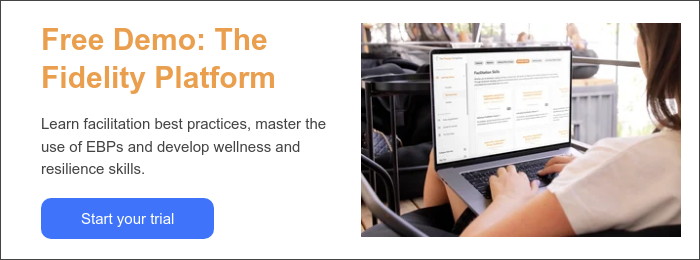Working with involuntary clients

In addiction treatment and justice services, facilitators and counselors often find themselves working with involuntary clients — those who have not willingly sought help or intervention. When working with involuntary clients, there are a few main areas to focus on:
- How you can engage the client and meet them where they are
- Ways to address reluctance and build trust
Meeting the client where they are
Use motivational interviewing
Motivational interviewing (MI) is a valuable tool to help determine where the client is today and what their goals are. Ask open-ended questions to ease facilitation. MI helps involuntary clients increase their arguments in favor of positive change.
Consider the stages of change
The stages of change model is another helpful gauge for where a client is today. However, psychiatrist and addiction specialist Dr. David Mee-Lee suggests there is a better way than using the stages of change to “label” clients. “If you use the stages of change to align with the client and form an alliance around what they are at Action for, then it is a useful model to help us stay clear on starting where the client is.”
The transtheoretical model (also known as stages of change) includes five stages:
- Precontemplation — “I don’t see a problem.”
- Contemplation — “I know what I want to change – I’m just not ready yet.”
- Preparation — “I am ready to make change a priority.”
- Action — “I focus energy on new habits.”
- Maintenance — “I keep reinforcing my commitment.”
Dr. Mee-Lee emphasizes acknowledging what the client is motivated for, which may seem unrelated to the behavior you think needs to change: “What [the client] may be motivated for and at Action for may be to get their children back, or to get off probation, or to stay out of prison or to keep their job… They may be in Contemplation for what we think they should change, but at Action for something we think is just secondary gain. But motivational enhancement and alliance building starts with what they want and works to see if they can discover how what they are doing is productive or counterproductive to getting what they want.”
Build the therapeutic alliance
The therapeutic alliance starts with empathy for what the client wants. This can help you and the client explore how their current behaviors contribute to — or hinder — their goals.
It is key for the client to take an active role in their treatment plan. Collaborate with the client to create a plan that aligns with their preferences. This collaboration fosters buy-in and adherence.
“Create a therapeutic environment where the person who knows their treatment plan best is the client. When the client views the treatment plan as a written expression of the alliance, the plan is their plan on how to get what they want. They should be the one to know their plan best. They should be the one to know what they want to get out of each group or individual session to advance their treatment plan. If they do not, there is a good chance it is your treatment plan focused on what you want the client to do, not what interests them,” says Dr. Mee-Lee.
When building a treatment agreement, you can value both your clinical expertise and the client's life experiences. You have the opportunity to empower clients to be assertive advocates for their needs. You also can provide evidence-based care and honest feedback on their goals.
“By all means explain to a client what is your best recommendation on what to do to reach their goal of coming to treatment… At the same time, collaborate with the client to fashion a plan that fits their style and approach,” adds Dr. Mee-Lee.
Working with involuntary clients calls for empathy, understanding and evidence-based intervention. To guide involuntary clients toward meaningful behavior change, embrace a client-centered approach. It is helpful to meet clients where they are, understand the stages of change and foster a therapeutic alliance based on trust.

